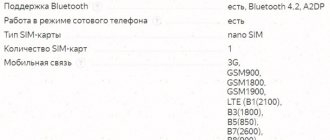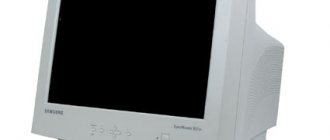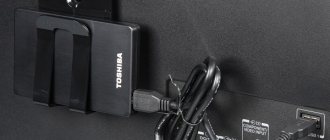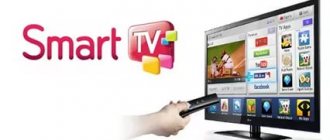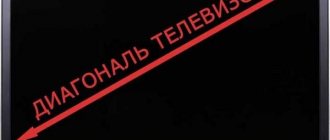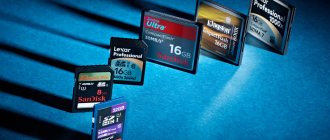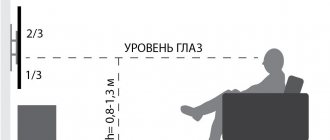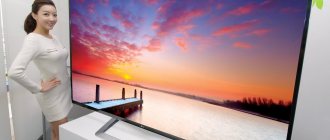Which tablet can be connected to TV?
A tablet of any brand (Apple, Lenovo, Samsung, Acer, Huawei) is capable of broadcasting images to a TV. Everywhere there is a connector into which the necessary cable is inserted, and the other end is connected to the TV receiver.
If your TV supports Wi-Fi, then syncing your tablet with it is even easier. Often you don't even need to download applications. The software of modern Smart TVs immediately includes functions for synchronization with mobile phones, tablets, and other multimedia devices.
Which method to choose
The choice of connection method depends on the end goal. For example, if you need to play an audio or video file from a tablet using the latter as a physical medium, a USB cable will do. You just need to connect with a USB cable. Select viewing the desired files and play.
If you need to synchronize the TV with the tablet so that the first one broadcasts the image from the second one, USB will not work. Another method will be required in which synchronization will occur. Then the TV will display a real-time picture from the tablet. The opportunity will appear:
- watch videos and films;
- use all the functions of the tablet.
The most convenient way is to use Wi-Fi technology. You can broadcast from anywhere in the room without cords.
When the TV does not have a built-in wireless module, Wi-Fi connection cannot be made. You will have to connect only with cables. To display the image from the tablet to a high-quality TV, you need to connect via HDMI.
The article does not describe the process of controlling a TV from a tablet. We are talking about viewing the contents of the phone on the TV screen, or displaying a picture that depends on the current actions. If you need to change channels via a tablet or phone, then “remote applications” are downloaded.
Wired connection
Connecting via cable is a simple, accessible and familiar method of transmitting information.
Carried out via ports:
- RCA;
- HDMI;
- USB.
Each of the connected devices must have a corresponding port. Make sure these ports are available. If they are not available, you will need to purchase an adapter.
Connection via HDMI
HDMI is an acronym for High Definition Multimedia Interface. HDMI is a way to transfer media data from one device to another, or a “hardware interface.” The connection is made through a wire with HDMI connectors at the ends.
Basic form factors, or size standards for HDMI ports:
- HDMI (Type A);
- mini-HDMI (Type C);
- micro HDMI (Type D).
The convenience of connecting via HDMI is due to the following reasons:
- Product prevalence. Many products go on sale with built-in HDMI connectors and are equipped with similar cords.
- The cable transmits digital data providing high quality images.
- Just 1 cable can quickly transmit both sound and video.
- Convenient functionality setup.
- Display mirroring is a way to broadcast images from a tablet to a TV.
How to connect a tablet to a TV via hdmi? When you establish a connection by inserting a plug, the devices will automatically try to establish contact with each other.
Connecting to a TV with wires
The wires included in the kit are used. Or cords with other interfaces are purchased to improve display quality.
USB
Used only to view the contents of the tablet. Surfing the Internet or going into the tablet settings will not work. You can only open video or audio if you download and upload the files to your tablet in advance.
Advantages
The connection can be made using a standard charging cable. At one end of the cable there is a plug for insertion into a standard device connector, at the other - USB.
Everything is done very quickly.
There is no need to purchase additional cables or install applications on the tablet. A standard cable will do.
The device charges automatically via USB.
You can view almost all file formats (depending on the TV).
For Android and iOS, the connection principle is the same:
- Insert one end of the cord into the tablet's charging socket.
- Insert the other end into the connector located on the TV. All interfaces are usually located on the back of the TV. Sometimes the connectors may be mounted on the side of the case.
- After a physical connection, the TV can detect the device itself and offer to select specific file types (audio or video). Select the option you are interested in and folders and files will be displayed on the screen. Find the file you need and run it.
- If automatic detection does not occur, then you need to display the files yourself. On the TV, you need to select a signal source in order for the image to be displayed from an external USB device. This is done through the TV settings or the remote control. The latter often has a “Source” button.
LG
Samsung
Click on it and select "USB". Switch the tablet from charge-only mode to data transfer mode. After connecting, the tablet itself can offer to make a choice, then there will be no problems. If the choice is not offered, and the content is not displayed on the TV after switching to the USB source, then you need to switch manually. Swipe your finger across the tablet display to open the shade with notifications and quick settings. Find the item where it says that the tablet is in charging mode. Click on it and change the mode to “File Transfer”, “Data Transfer”, “Use as an external drive”, or the like. - Use the remote control to navigate through folders, search for files and view them.
HDMI
Connecting a tablet to a TV via HDMI for watching movies is a priority over USB, since the signal is transmitted digitally in maximum quality. You can watch it even in 4K resolution. Once connected, the screen will be broadcast on TV.
An HDMI cable is required for connection. It may come with the tablet in a box, or it may require an additional purchase. You can buy it at any computer or household appliance store.
There can be two types of cable:
- on both ends there are identical plugs of a standard size (Standard, Type A);
- when at one end the plug is purely for the tablet (mini HDMI, Type C).
In the first case, an adapter may be required, since not all tablets, especially older models, have an HDMI type A connector.
Adapter from HDMI Type A to HDMI Type C
In the second, connection is possible directly with one cable directly from the tablet to the TV.
The connection is made in the same way:
- the equipment is connected to each other by cable;
- the TV is set to the correct signal source (HDMI);
- A picture will appear on the screen that corresponds to the image of the tablet at the current moment. All actions performed on the device will be duplicated on the television panel in the stream.
MHL (Mobile High-Definition Link)
Once connected, the tablet will transmit the image and charge at the same time. The technology combines HDMI and USB functions.
Externally it looks like a regular wire, at one end of which there is an HDMI interface, at the other - Micro-USB.
There are two types of cable:
- Passive. A plug at both ends of the cord. Suitable only if the TV and tablet simultaneously support MHL technology. You can find out about support by marking the HDMI connectors on the back of the case. “MHL” will be written next to it. Externally, this is a regular adapter cable from microUSB to HDMI. Apart from connecting, you don't need to do anything else.
- Active. An additional USB connector is attached to the end where the HDMI plug is located. Used to connect a power adapter (5V, 1A). An active cable is required if the TV receiver does not support MHL. But the tablet must work with the technology. Without power supply to the adapter, the HDMI output signal will not appear.
There is another type of adapter that has a standard USB plug. It plugs into a USB connector and powers the adapter while simultaneously charging the tablet.
Additionally, there is an MHL adapter, which also has two connectors - for connecting power and a regular HDMI cable.
Modern Samsung mobile devices are equipped with an enlarged charging connector. Therefore, another adapter is needed to connect.
RCA
Many people are familiar with the cable, on one or both ends of which there are three plugs of different colors. Yellow to transmit image, red and white to transmit sound on the right and left audio channels, respectively.
You can use a component cable. It has 5 plugs, which gives a higher-definition picture by dividing the video signal into several channels.
Only an analog signal is transmitted through the cable. In addition, tablets do not have RCA connectors on their bodies. Therefore, you need an HDMI-to-AV adapter that will allow you to connect your tablet and convert the digital signal to analog. A regular cable without a converter will not work. Signal conversion is required, otherwise the broadcast will not work.
The advantage of the method is that you can connect to an old TV that no longer has any multimedia connectors.
VGA
Technology primarily for connecting monitors to the video card connectors of computers or laptops. But, it can be used to connect to tablet technology.
To organize the connection, you need to make sure that there is a VGA connector on the TV panel. Indicated by blue (more often) or black (less often) color. The plugs on the cable have similar color markings.
An HDMI-VGA adapter is required, since the tablet does not have such a connector.
VGA only transmits video signals. Therefore, additional care should be taken about sound reproduction. On the tablet, connect external speakers to the standard audio jack. Or take an adapter that additionally has a similar audio connector. In the image of the converter above you can see that next to the VGA output there is a connector labeled “Audio”. A mini-Jack to 2RCA cord comes from it.
The first plug (standard from headphones, 3.5 mm) is inserted into the adapter, and the tulips into the audio input on the TV.
Slimport
Direct competitor to MHL. Designed to transmit audio and video signals to TVs, projectors, monitors and other output devices.
The video is transmitted in a maximum resolution of 1080p, and the frame rate is 60 Hz.
While watching, if a call is received on your mobile phone, the transmission is interrupted. When you pick up the phone, the conversation will be conducted through the speaker built into the tablet. Once the conversation ends, browsing will automatically resume.
Additionally, the Slimport can have a built-in socket for connecting a power supply.
The adapter requires an HDMI cable no longer than 5 meters to avoid signal loss. When purchasing the Slimport adapter itself, you need to pay attention to the cost. A cheap adapter can cause interference or no signal at all.
Connection via wire
Wired methods of connecting a tablet to a TV are convenient because the user does not have to download and install additional software. Wired synchronization is suitable for owners of devices that do not support Smart TV. To connect via cord, use one of the following interfaces:
- HDMI;
- USB;
- MHL;
- RCA;
- VGA.
Now let's analyze in detail the advantages and disadvantages of all methods.
HDMI
Connecting your tablet to your TV via HDMI is one of the most effective synchronization methods. The tablet will partially perform the functions of a Smart set-top box. What needs to be done to set up such a connection? First, you should purchase an HDMI cable. The wire is sold in all electronics stores and supermarkets. Secondly, if the tablet does not have an HDMI interface, then you will have to buy an adapter that plugs into the USB interface. Sometimes this adapter is included in the basic package of the tablet.
How to connect a double cord with equipment? All connection details are described in detail in the user manual. Simply insert the cable plugs into the appropriate sockets. There's nothing complicated. Mostly the HDMI interface is located on the back of the TV, sometimes on the side.
- Setting up audio and video transmission is carried out automatically immediately after both devices are connected by cable. If there are problems with the transmission, then debugging is carried out manually. Take the TV remote control, and then select the HDMI port as the signal source. In the settings you also need to set the input value for this interface. Data output must be set in the tablet settings via HDMI.
- Developers are constantly improving HDMI, trying to improve picture quality and increase data transfer speeds. Therefore, the generations of the interface on TV and tablet may not match. In this case, you need to use the adapter that we talked about earlier. This is the most practical solution to the compatibility problem.
- The new HDMI 2.0 standard is enough to transfer images with 4K resolution to a large screen. The picture will be as natural and clear as possible. The channel capacity increases to 18.2 Gb/s. This standard appeared relatively recently. Therefore, it is extremely rare on devices.
When the connection is finally configured, the tablet's desktop will appear on the big screen. Control is carried out using a tablet. Another advantage of HDMI is that this interface allows simultaneous transmission of audio and video. Therefore, there is no need to use additional cables.
In the tablet settings, you can activate the “Display mirror” option so that the image is duplicated. The user will be able to play video games on the big screen, as well as use various applications: Viber, Skype, WhatsApp and other utilities.
USB
A USB cable can also be used to set up synchronization. However, this interface will not allow you to duplicate an image. The connection is designed to use the tablet as a removable memory storage device. The user will be able to view photos, play videos and include any other content.
To set up synchronization between your tablet and TV via USB, connect these devices using a cable. The cord is included in the basic package of all tablets, since the gadget is charged through it. Open the signal sources on your TV, and then select the USB port. Using a file manager, you can navigate between folders. Select the desired file, and then play it. Control is carried out by remote control.
What to do if the TV does not see the tablet via USB? This problem can occur for several reasons. First, check if the interface is damaged. It is possible that the contact pad of the connector has oxidized. Secondly, start the data transfer mode on the tablet. Thirdly, the cable itself may be causing the problem. In this case, try a different USB cable.
MHL
You can also connect your tablet to your TV using MHL. This is a special adapter from USB to HDMI, which allows you not only to broadcast high-quality images to a large screen, but also to charge the tablet at the same time. The cost of the device is relatively small. You can buy it at any computer store.
The algorithm for setting up synchronization is not much different from the previously described methods. You need to insert the wires into the appropriate connectors, and then select the signal source on the TV.
RCA
The RCA interface is a familiar “tulip” to everyone. The main advantage of this connector is its versatility. Using RCA, you can even connect an old CRT TV to the tablet. "Tulip" is presented in the form of a coaxial cable. There are three plugs at one end: red, white and yellow. Each plug must be inserted into a port of the corresponding color on the TV panel.
Connecting via a “tulip” allows you to use the tablet as a flash drive. This means you can view photos, play videos and watch movies. You won't be able to duplicate the image. The RCI interface is an analog port, so in addition to the tablet you need to connect a charger so that the device’s battery does not run out.
Not all devices can be synchronized using this method. This is explained by the fact that “tulip” is an analog technology; many popular gadgets today do not support it at the hardware level.
Tablets are not equipped with RCA connectors. This means that the user needs to purchase a special adapter in advance that will convert the digital image to analog. When the adapter is connected and the devices are connected with a special cable. Take the remote control and open the basic settings of the TV. You must select an output device mode.
VGA
Old TVs are equipped with a VGA output, which can also be used to set up synchronization with a tablet. This technology is significantly outdated, but is still used in rare cases. First you need to get a special adapter; it will connect via a USB connector or an HDMI interface.
Separately, you need to think about how you will output sound to the TV. Since the VGA interface is designed to transmit exclusively video signals. The audio signal can be transmitted using a special cable or speakers. This method is mainly used to connect a computer to a TV.
Wireless tablet connection
You can get by with standard TV functionality. Sometimes you will need to install additional applications. To implement an over-the-air connection, only Smart TV is suitable. The brand is not important, all Smart TV receivers are designed for wireless pairing.
The main disadvantage of connecting your existing tablet to any TV via Wi-Fi is connection problems.
Various factors can lead to loss of communication, for example, the operation of other equipment in a room that is located close and emits strong electromagnetic waves. There will be no problems viewing photos and films. But playing is unlikely to be comfortable, as there are slight delays. In addition, you need to constantly look at the tablet screen to press the correct buttons.
Wi-Fi broadcasting greatly drains the tablet. In order for the image to be jerk-free with minimal delays, the Internet speed should be as high as possible.
Wi-Fi Direct
Depending on the TV model, year of manufacture and brand, the use of the function will differ.
On new models, you do not need to additionally enable the direct Wi-Fi connection function. Direct communication operates in constant mode. Therefore, you only need to send the document via Wi-Fi Direct from your phone. And on the TV, agree to the connection request.
If the TV is outdated, then all functions will have to be turned on manually. And only then connect from your phone.
General instructions:
- You need to go to the tablet settings.
- Next, go to “wireless networks”, “Wi-fi”. Already at this point there may be the “Wi-fi Direct” setting we need. If there is no function, then look for additional items inside the wireless settings. It is possible that the option is enabled within them. After that, the phone will automatically start detecting other devices that have the direct Wi-Fi connection option enabled.
- Enable Wi-fi Direct on your TV. Let's look at the example of an LG Smart TV. Open the menu with the “Settings” button (signed with the same word or indicated by a gear).
Go to the “Network” or “Connection” section, activate Wi-fi Direct.
If Wi-fi Direct was previously enabled on the tablet, then the TV will find it in the list of available connections. You can select the tablet from the list on the TV. A confirmation message will appear on your mobile device; you must agree. The connection can be made in reverse. First, activate Wi-Fi Direct on your TV. Then turn it on on your phone, wait for the network to scan and select the found TV. Then also agree to all requests.
The general algorithm of actions is described. The names of the items may differ greatly both on television equipment and on a tablet. The main task is to find the setting on all devices, enable and synchronize.
On new TVs there is no “Wi-Fi Direct” item in the settings.
For example, on the 2021 model “LG webOS TV UM7050PLF” this setting no longer exists. And any wireless connection with external mobile gadgets is done through the built-in Screen Share function. Nothing is done on the TV itself other than confirmation. Although, some older models, even with such functionality, require you to first launch the application before connecting your phone or tablet.
If you also have a new TV, then try to connect immediately without changing any parameters. Almost every smartphone or tablet has a function that broadcasts the screen. It can be located inside the settings, or in the quick access panel. The latter is located next to notifications if you wave your finger from the top edge of the screen.
Possible names:
- broadcast;
- projection;
- wireless monitor;
- Miracast;
- Screen Mirroring;
- and others similar.
On HUAWEI smartphones, the general settings menu inside the “Device Connection” item contains the “MirrorShare” function. It works great, you just need to choose the right TV. The connection is made using Miracast technology (discussed below), which operates on a direct connection through an internal Wi-Fi Direct access point.
After clicking on the option, a search for available connections will begin. When the TV is detected, click on it and confirm the connection request with the remote control. When synchronization is complete, all actions performed will be broadcast.
The orientation of the picture on TV will depend on the orientation of the tablet (vertical/horizontal) and the state of the Auto-rotate function. In order for the picture to fill the entire screen, the tablet will have to be positioned horizontally.
Miracast
The technology allows for connection and broadcasting on different operating systems in good quality. Not all TV receivers support Miracast; even some new models do not have such a connection. If the TV has Miracast, then you don’t have to do anything to connect, not even connect the TV to the Internet. Pairing will be via the internal Wi-Fi network.
If Miracast is not available, you will have to connect the set-top box to the USB port of the TV.
Instructions:
- if required, activate the Miracast option on the TV (in the network/Internet/connections settings or in the sources/applications menu). For example, on some new LG devices, you need to launch the Screen Share application in the application bar (Home button).
After startup, the connection waiting screen will appear (then proceed to the next point).On the newest versions of LG webOS, the application does not need to be opened. Miracast works in the background and will respond to any external connection. You just have to make a confirmation.
On Samsung TVs before 2021, you need to open the “Source” menu and select the “Screen Mirroring” option.
The connection waiting screen appears.
Start wireless Miracast broadcast on your tablet and accept the request on your TV.Samsung TV series after 2021 release (K, N, M, Q, LS, R, T) have removed the manual method of launching the Miracast standard. As with the new LG panels, the technology is always on.
You only need to click on the “Allow” or “Accept” button on the screen.
- On your tablet, find the option (the names are listed below) that starts the broadcast, activate it and connect to the found TV.
The Miracast option on a gadget can have different names and be located in any menu item. Focus on the following names:
- “wireless connection to display”;
- "wireless projector";
- "wireless display";
- "Miracast display mirroring"
- "broadcast";
- "PlayTo";
- Miracast;
- "Screen Mirroring";
- MirrorShare.
The options are most often found in the additional settings of wireless networks or the screen. You should also look for Miracast inside the “Connections” menu, if this is provided by the tablet software.
It would be a good idea to check the quick access menu. Pull down the notification shade and find the broadcast icon.
Airplay
The technology is developed only for Apple equipment. You can connect your iPhone, iPad to your TV, or broadcast from MacBook screens. On the iOS operating system, the feature is called Screen Mirroring.
It's easy to duplicate the screen when the Apple TV module is built into the TV. You can find out about availability through the installed application.
If you have Apple TV, then you need to open the curtain on your iPad or iPhone and click on “Screen repeat”.
Next, the TV will be detected and the model will be selected. If necessary, change the position of the slider opposite the model to the on state.
The TV screen will display a 4-digit pairing code. Enter it in the field on iPhone, iPad, MacBook.
You can interrupt the broadcast via AirPlay by clicking on “Stop repeating”.
The situation is more complicated when the TV does not have Apple TV or is not a Smart TV at all.
- In the first case, you will need to install the application. For example, free AirScreen.
- If there is no Smart TV, then additional equipment is needed. The Apple TV set-top box has been in production for a long time. Externally it is a dark little box. You need to connect the set-top box to your TV and one Wi-Fi network. You need to connect according to the instructions above, just select a set-top box from the list, not a TV. An alternative could be any other TV Box on Android OS that will perform the tasks we need.
When the non-original “box” works, the AirScreen application (free) is downloaded through the Play Market. Then the screen repeat is done according to the already described algorithm.
Allshare
An analogue of Airplay, but an application has been developed to work with Samsung equipment. The main task is to link Samsung devices together in a single network. You can then view files between devices.
This is an outdated option; the function is not available on current versions of Samsung Smart TV.
- Connect your TV receiver and tablet to the same Internet network.
- Both devices must have the Allshare app. Launch the program everywhere, log in to your account or create a new one if you have not registered before.
- Then view your media files on any connected device. To display a video or photo from your tablet, you need to open the desired file and click on the broadcast icon at the top of the screen. Afterwards the image will automatically appear on the big screen. If the tablet asks you to select a target device to display, then do so. The second option is to display all folders by category (video, pictures, sound) through the TV without even touching the tablet. Go to the main menu by pressing the “SmartHub” button (multi-colored diamond) on the remote control, open Allshare. Navigate through directories and view content on a large diagonal.
The disadvantage of the application is that you cannot broadcast any menu. The main purpose is to provide public access.
Samsung Link
Identical application to the previous one. A complete replacement for Allshare. Built into the operating system. The developers no longer support the application. No updates are released. The application is intended for the same purpose - to share files only between Samsung devices. It differs from its predecessor in the presence of cloud storage.
To work you need to follow the same steps.
Google Chromecast
Multimedia player for playing video and audio via the Internet or from connected devices.
Connects to any output device, including a TV via HDMI. Additionally, power is required via the USB port. The latter can be connected to the television or separately via a power adapter into an outlet.
- First, connect your Chromecast to your TV correctly.
- On Android, install the Google Home app.
- Launch the application, wait for the TV to be detected and synchronize. The process can happen without your participation. The authentication code will be displayed on the TV; enter the numbers on your smartphone/tablet.
- Then connect the player to Wi-fi.
After setup, many different services will appear on the TV panel. You will be able to watch TV shows, movies, etc.
In addition to the original Chromecast player, you can use other manufacturers. Devices capable of displaying images in 4K resolution cost significantly more than those designed for 1080p.
DLNA
The essence of the method is to create a single multimedia server. You will need one of the applications on your mobile. device, and the ability of the TV to work with DLNA. Modern TVs with Smart TV support are suitable for this purpose.
Depending on the application, connection and other steps differ.
- You can select and open files only from a television device or only from a tablet. Option No. 1: a server is created on which access to the folder on the tablet is open. Through the TV, you can open the server and view the multimedia files that are inside the open directory. We only work with files to which access has been granted in advance. There is no way to duplicate from YouTube or online viewing sites. Option No. 2: control is done via a tablet. The equipment is being paired. The required files open inside the interface. In the application, the content is sorted by type. In the first option, the tablet only creates a server, and all actions for connecting and playing are done from the TV. In the second option, the TV only receives the signal over the network, and control is done on the tablet. The second option is more convenient due to its simplicity.
- You can only view files through the server or stream videos from Youtube or a browser. Each application has its own set of functions. In one you can only display photos and videos and play music. In another, a browser is additionally developed. Then you can go to some website and watch a movie.
Duplicating an image using this method is not possible.
To connect via DLNA, you must meet the following requirements:
- router that distributes the Internet;
- tablet and TV connected to the router via Wi-Fi (cable possible).
Further all actions are determined by the application. The following can be distinguished:
- DLNA Server;
- Allcast;
- Web Video Caster.
The last application will be the most convenient; it has a built-in browser.
It may happen that one application will work and another will not. There are many free applications that you can try.
Web Video Caster
The application is free and available on the Play Store.
- Install, launch, click on the broadcast icon in the upper right corner.
- Click on the settings icon.
- Select the device you want to scan, click "Done".
- Your TV receiver should appear in the list, connect to it.
- Open the main menu of the application (three bars on the top left) and select the display option. You can immediately go to your browser, open Youtube and watch any video. Or open the “Phone Files” section, and then, in the required tabs (categories), launch the file.
Allcast
Similar to the previous one, but with significantly more advertising. There is no browser, only viewing saved files in the tablet’s memory is available. Once launched, detection begins immediately.
Find the file through the menu and run it. The “Gallery” section contains pictures and video content, and the “Audio” section contains sound files.
DLNA Server
The application only creates the server.
- After opening the application, click on the “+” icon in the top menu.
- An empty field with three buttons will appear. Click on the one on the far right.
- Go to the folder where the files you want to display on your TV are stored. Click on the checkmark in the menu.
- The application will write that the server is running with information about its IP address.
- On your TV, go to the sources (connections) menu and select the “DLNA” option. The desired connection can be called by the name of the tablet/phone.
- In Explorer, find the content you need and launch it.
Wireless connection
Cable connections have long been replaced by wireless analogues. Wires are outdated and no longer seem like a convenient way to transfer data. Cable connections are being replaced by new technologies that make the process of pairing devices even easier and more accessible. Some TV manufacturers specifically develop applications for connecting tablets and smartphones.
There are many ways to connect a TV to a tablet wirelessly, including:
- WiFi
- Miracast;
- AirPlay;
- Bluetooth.
Thanks to wireless technologies, unnecessary accessories are no longer required, and setup and pairing of devices is also faster.
Wi-Fi Direct
This method will be most suitable for Smart TV owners, since they have a built-in Wi-Fi adapter. It is important to consider that for successful pairing, the TV must also support the Wi-Fi Direct function.
Instructions for turning on:
- Go to tablet settings. The “Wi-Fi Direct” option is located in the wireless networks section and needs to be activated.
- Then go to the TV transmitter settings.
- Go to the “network” section on your TV and also select the “Wi-Fi Direct” function.
- By selecting this item, an additional window will open where you need to click on “On”, after which the synchronization of the device with the TV will be activated.
To control TV from the tablet and expand its functionality, you will need to additionally install an application from Google Play.
Otherwise, only viewing photos, listening to music and broadcasting non-streaming videos will be available.
Transfer via Miracast
It is an absolutely innovative protocol that allows you to display a picture from your gadget on a large screen. This technology has not yet been widely used, but still deserves special attention.
Although Wi-Fi Miracast is still in the testing phase, some devices already have this feature.
To check its availability, you will need to go to the device settings, open the “screen” section, at the bottom of the menu there is a line called “Wireless projector”. May have a different name depending on the model used.
Check the launch of the function, and in the TV settings, activate it. Next, the Smart TV will independently connect to the device, making a wireless connection.
Attention: Due to the fact that the function is still at the development stage, failures may occur due to a mismatch between the software and module versions.
AirPlay
Apple offers its unique solution for connecting a tablet to a TV. However, the developed standard only works with Apple gadgets.
Using AirPlay, you can display images from your tablet on your TV to view photos and videos on a large display.
At first, technology was used to transmit data. Later they began to use it as an actual method for transmitting high-quality video signals to TV.
The devices pair automatically using special software and connect to the same network.
AirPlay allows you to view photos and videos on a large TV screen, as well as conduct presentations using an iPad, displaying data on a projector.
Samsung Link
It is a specialized utility that is a kind of analogue of AirPlay from Apple, only in the Android world. It was developed by the Korean company Samsung specifically for its branded gadgets, including tablets.
To connect, you need to connect both devices to the same Internet network. Then we connect to the official Samsung Smart View application, which is freely available in the play market.
After syncing your gadgets, select the files you need and send them to the large display. This technology is not as popular as other options because it does not support mirror replay.
Allshare module
This program was developed by Samsung and is distinguished by its functionality and multitasking.
This software was created for Samsung gadgets and helps devices exchange data if they are connected by the same local network.
For unknown reasons, this software has not gained much popularity, but it is still worth considering how a Samsung tablet connects to a TV. The devices are connected to each other in a simple way:
- Before directly displaying the image on the screen, you will need to launch the software, first checking the operation of Wi-Fi.
- The tablet needs to be connected to the TV, thanks to automatic configuration, a connection between the gadgets will be established.
If the TV receiver does not have this function, you will need to purchase a special adapter that allows you to pair Samsung gadgets without the AllShare module.
Bluetooth
Bluetooth is primarily used to play sound from a tablet. It is for this reason that Bluetooth supports communication with today's popular headphones.
This method can be easily applied using special software. You will need to download the application for your operating system from the market.
However, it is impossible to transmit a video signal in real time via Bluetooth, which causes the image quality to seriously deteriorate. This is why the technology is not used for video broadcasting or is done extremely rarely.
If you specifically require video playback, it is better to use a Wi-Fi connection, since it can be called the most practical way to synchronize gadgets.
The TV does not see the tablet
- When connecting cables, inspect them for damage, severe bends, and other mechanical damage. Check the plug contacts externally. They may be heavily soiled or damaged. Try connecting with a different cable.
- Partial use of connectors leads to their loosening. As a result, the contact of the connector with the board is broken. The solution is to restore contact. Additionally, the connector itself may break, then the only way out of the situation is to replace the part with a new one.
- Don't forget to indicate the signal source on your TV.
- If you cannot connect wirelessly, it is likely that the equipment is not on the same network. Or the application is not compatible with the TV. Try a different synchronization technology, preferably one without apps. It's always better to use built-in functions.
